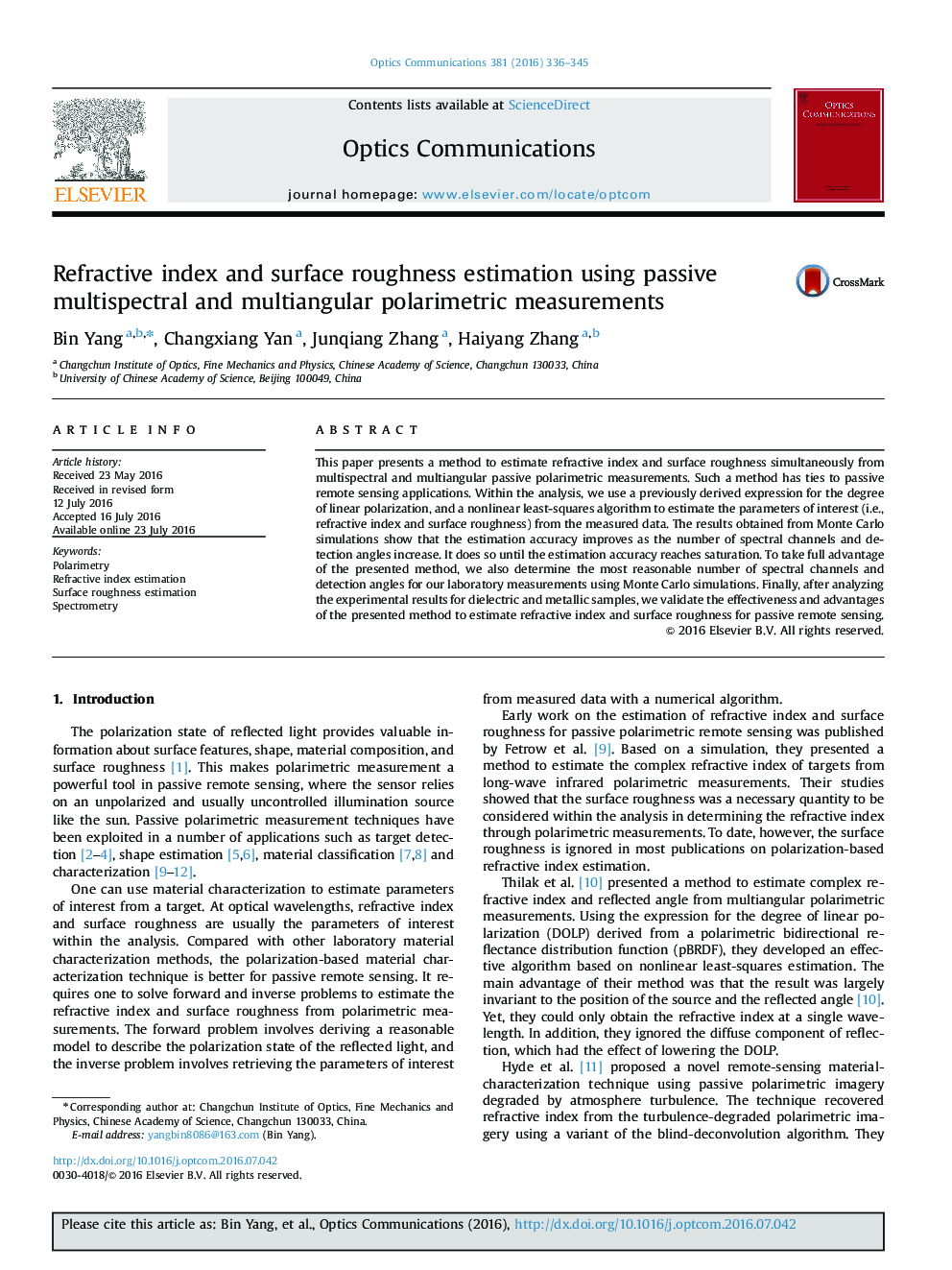| کد مقاله | کد نشریه | سال انتشار | مقاله انگلیسی | نسخه تمام متن |
|---|---|---|---|---|
| 1532973 | 1512542 | 2016 | 10 صفحه PDF | دانلود رایگان |
عنوان انگلیسی مقاله ISI
Refractive index and surface roughness estimation using passive multispectral and multiangular polarimetric measurements
ترجمه فارسی عنوان
شاخص شکست ناپذیری و برآورد زبری سطح با استفاده از اندازه گیری های قطبی سنج چند ضلعی و چند ضلعی منفعل
دانلود مقاله + سفارش ترجمه
دانلود مقاله ISI انگلیسی
رایگان برای ایرانیان
کلمات کلیدی
قطبش سنجی، برآورد شاخص انکسار، برآورد زبری سطح، طیف سنجی،
ترجمه چکیده
این مقاله یک روش برای ارزیابی ضریب شکست و زبری سطح به صورت همزمان از اندازه گیری های قطبی سنج منفعل چند وجهی و چندگانه است. چنین روش متصل به برنامه های سنجش از راه دور است. در تجزیه و تحلیل، از یک عبارت قبلی برای قطبی شدن خطی و یک الگوریتم کمترین مربع غیر خطی برای تخمینی پارامترهای مورد نظر (یعنی شاخص شکست و زبری سطح) از داده های اندازه گیری استفاده می کنیم. نتایج حاصل از شبیه سازی های مونت کارلو نشان می دهد که دقت برآورد به افزایش تعداد کانال های طیفی و زوایای تشخیص افزایش می یابد. این کار را تا زمانی که دقت تخمینی به اشباع می رسد. برای به حداکثر رساندن استفاده از روش ارائه شده، ما همچنین تعداد قابل توجهی از کانال های طیفی و زوایای تشخیص برای اندازه گیری های آزمایشگاهی ما با استفاده از شبیه سازی مونت کارلو را تعیین می کنیم. در نهایت پس از تجزیه و تحلیل نتایج آزمایشگاهی نمونه های دی الکتریکی و فلزی، اثربخشی و مزایای روش ارائه شده برای تخمین شاخص ریزنشت و زبری سطحی برای سنجش از راه دور منعکس می شود.
موضوعات مرتبط
مهندسی و علوم پایه
مهندسی مواد
مواد الکترونیکی، نوری و مغناطیسی
چکیده انگلیسی
This paper presents a method to estimate refractive index and surface roughness simultaneously from multispectral and multiangular passive polarimetric measurements. Such a method has ties to passive remote sensing applications. Within the analysis, we use a previously derived expression for the degree of linear polarization, and a nonlinear least-squares algorithm to estimate the parameters of interest (i.e., refractive index and surface roughness) from the measured data. The results obtained from Monte Carlo simulations show that the estimation accuracy improves as the number of spectral channels and detection angles increase. It does so until the estimation accuracy reaches saturation. To take full advantage of the presented method, we also determine the most reasonable number of spectral channels and detection angles for our laboratory measurements using Monte Carlo simulations. Finally, after analyzing the experimental results for dielectric and metallic samples, we validate the effectiveness and advantages of the presented method to estimate refractive index and surface roughness for passive remote sensing.
ناشر
Database: Elsevier - ScienceDirect (ساینس دایرکت)
Journal: Optics Communications - Volume 381, 15 December 2016, Pages 336-345
Journal: Optics Communications - Volume 381, 15 December 2016, Pages 336-345
نویسندگان
Bin Yang Bin Yang, Changxiang Yan, Junqiang Zhang, Haiyang Zhang,
